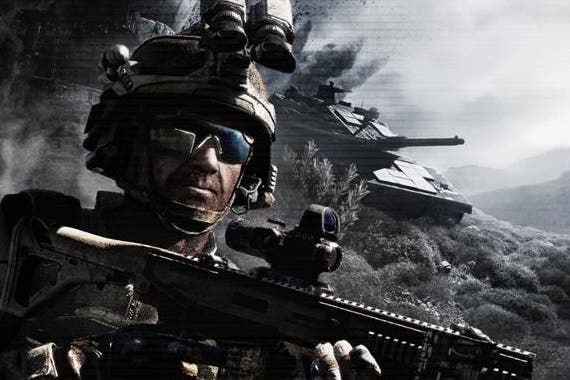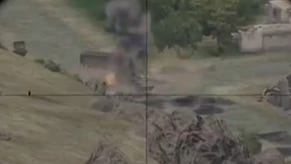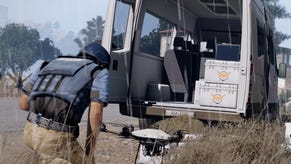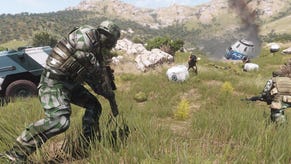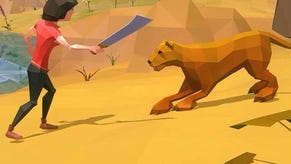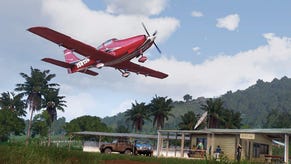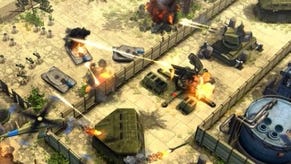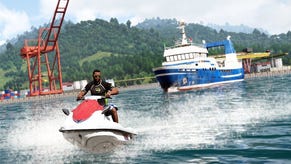Arma 3 review
Combined arms.
It's the dead of night on the CSAT-occupied island of Stratis, and the peaceful darkness is about to explode into chaos. I'm leading one of two spec-ops teams on a mission to liberate the leader of a local guerrilla faction and return him to the much larger island of Altis. A British squad is in charge of the actual rescue. Our job is to cause as much trouble across the island as possible to distract the CSAT forces and give the British the opening they need.
Over the next hour, that's precisely what I do. Inserting by boat from the northwest coast, I head south and raid an ammo dump before cutting across to the eastern shore to destroy a heliport. Then my squad suppresses an enemy encampment from a hillside near the centre of the island as I swoop in from the west to flank them. Yet before we can regroup, my entire team is killed by reinforcements descending from the north, and the British still need more time to complete their mission. Alone, I rush to the southernmost tip of the island, where I blow up a fortified anti-air position before escaping by riding a quad bike back through the swarming enemy forces to the extraction point, where the boat takes me home.
Arguably the biggest complaint about Bohemia Interactive's post-Flashpoint games is that their campaigns haven't used the magnificent landscapes they create to their full potential. The first Arma's campaign was a hastily cobbled-together disappointment, while it took a certain zombie-survival mod to harness the austere and foreboding power of Arma 2's Chernarus. That Arma 3 uses half an island for just one of its twenty-odd missions is indicative of Bohemia's effort to resolve this ongoing issue. Indeed, taken as a whole, Arma 3 strives to make this deep and impenetrable military simulator series a more comprehensive, more engaging and more user-friendly experience. It isn't completely successful, but I had an awful lot of fun watching it try.
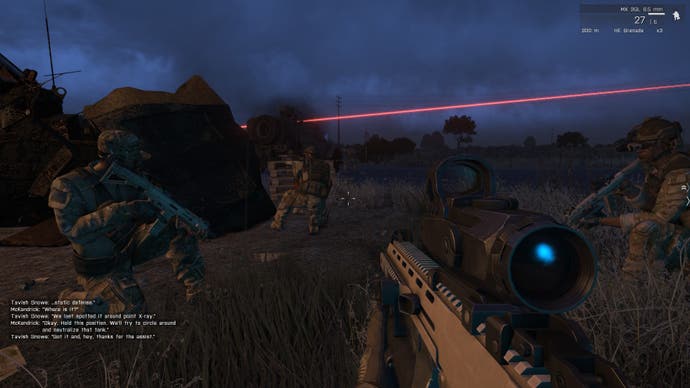
While Arma 3 was officially released back in September, the campaign has been portioned out in three substantial chunks over the last six months. Each chapter is a self-contained entity with its own story arc and theme; combined, they tell the tale of the excitingly named Corporal Ben Kerry and his role in the war over the fictional Mediterranean island archipelago of Altis and Stratis, waged between four different factions.
The first part, Survive, is geared towards introducing players to Arma. It takes place entirely on the smaller of Arma 3's two islands, Stratis, and sees Kerry banding up with a group of NATO survivors after the local Altian Armed Forces, backed by NATO's eastern equivalent CSAT, rise up against the local US garrison. For the most part, missions are small-scale skirmishes that keep you firmly in the "follower" category while teaching you the basics of minimising your daily lead intake. Rescuing a downed helicopter crew instructs you on establishing a defensive position, while a midnight liaison with local militia explains how to flank and clear buildings.
It's hardly the campaign's most spectacular stage. Story-wise, it's let down by voice acting that ranges from passable to cringeworthy and a script that understands military radio chatter but not how human beings interact with one another. Even here, though, Bohemia's approach to maximising the assets it has built is apparent. Missions are nearly always multi-staged, with objectives being added and changed as events rarely go according to plan.
Arma 3's campaign is a big, powerful, deeply engrossing thing

While it smoulders rather than sparks, Survive concludes strongly and the momentum is carried over into Adapt, definitely the best of the three chapters. This introduces Altis, a masterwork of environmental design. I could write another 1000 words on its remarkable sights and sounds: its misty dawns, crimson dusks and streetlight-speckled nights. But what's most important is how the detail that's gone into mapping the landscape's undulations - the lumps and bumps, hills and valleys - plays into the game's combat. A little rise in the ground might be the difference between life and death as you throw yourself down in evasion of the fiendishly accurate enemy AI. When they stop to reload, you'll rush to locate a better vantage point, order your men to "find cover" (an extremely handy new command) and plant half a dozen bullets in your opponent's surprisingly tough body.
Tactics are vital in Arma 3, but it's terrain that really makes the difference between success and failure. It's crucial to learn this before Adapt begins, because the difficulty suddenly ramps up. The first mission sees you alone, unarmed and with a city full of enemy soldiers between you and any kind of safety. At this point, setting saves to unlimited using Arma's highly customisable difficulty levels becomes a necessity. Fittingly, after Survive, you will die many, many times. That said, it's important to note that combat is more satisfying than before thanks to improved animations, smoother weapon handling and better optics - meaning the challenge stems from your opponents rather than clumsy controls and slow-to-aim weapons.
Adapt also changes the way you play. It gives you a squad to control, which is a mixed blessing. AI units tend to be much more perceptive of enemy locations than you are and are especially useful when facing down tanks and APCs, but they also require a fair amount of babysitting to keep them alive, and the lack of changes to Arma's squad commands means this can be a chore. Especially problematic is AI ammo management; your teammates go through bullets like a swarm of locusts through a corn crop, and resupplying them in the field is a nightmare in Arma 3's clumsy interface.
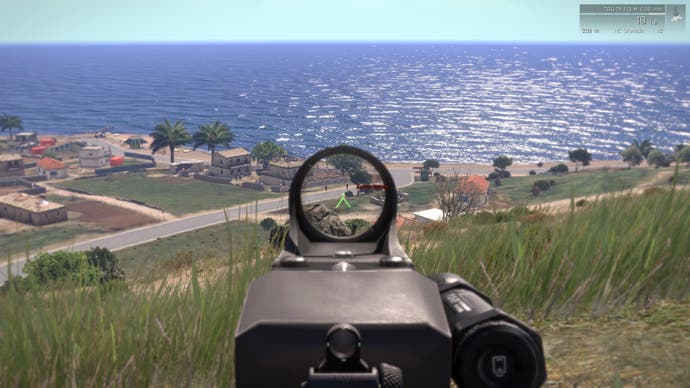
Alongside its story missions, which include the brilliant raid on Stratis described above, Adapt also introduces an open-world component. From your base you can go out on "Patrol" and complete multiple optional objectives, from clearing enemy checkpoints to smoking out a sniper hidden inside a labyrinthine industrial complex, all while collecting weapons, ammo and equipment to use during the main missions - though the clunkiness of Arma's inventory management means this is less enjoyable than it should be. If you want to bring stuff back to base, you need to find a vehicle and load it item-by-item from your own inventory, while before each mission the game defaults to a standard equipment loadout and items you previously had can be lost in this process.
After the meatiness of Adapt, the final chapter Win feels fleeting by comparison, with only six missions to its name. But they're also the most spectacular, displaying vast, combined-arms battles that cover sweeping areas of Altis. It's strongly reminiscent of the opening of Operation Flashpoint, but with you in control rather than being led by an AI squad leader. In these closing stages you can call in devastating artillery strikes and helicopter assaults, simultaneously demonstrating the sheer destructive power of modern warfare and your own insignificance in the scale of things. Story-wise, it's also the most interesting segment, making unsettling use of its near-future setting and offering a branching conclusion that is fascinating, whichever direction you take.
Arma 3's campaign is a big, powerful, deeply engrossing thing, but there is one disappointment: its lack of vehicular missions. Since the story focuses on one not particularly interesting character who is ultimately a grunt, there are no tank missions, no helicopter missions and no jet missions. I can understand why, to a point: Arma's vehicles, especially its airborne offering, take time and effort to learn to control. Moreover, in these kinds of games infantry combat tends to be more enjoyable anyway. On the other hand, Flashpoint offered plenty of vehicle engagements during its campaign without any issue, and it's frustrating that, 13 years on, Arma's campaigns still lag behind it in terms of breadth of experience.
A lengthy paid alpha followed by six months of staggered campaign releases has given Arma 3's multiplayer an extraordinary range
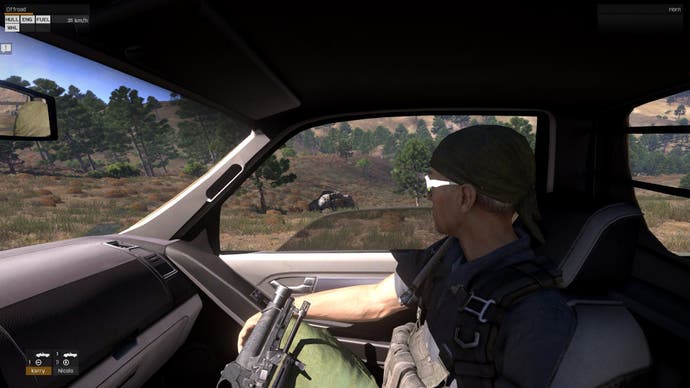
If you want to get familiar with Arma's military machinery, you'll need to look to the showcase missions, download one of the many community-built scenarios out there, or jump into the enormous multiplayer. Paul Dean covered these modes at the time of the game's launch last year. There are a vast range of multiplayer game modes to take your fancy. King of the Hill challenges three teams of 16 players to wrest control of a particular objective using small arms, tanks, helicopters, the works. If you're of a more co-operative bent, there are a range of developer missions that require teamwork to beat the odds, including the enormous Escape From Altis mission, which tasks your plucky group with safely reaching the coastline while avoiding the sights of a vastly superior enemy force.
Yet the most interesting of Arma's multiplayer modes stem from the community. Wasteland is a survival mode in a similar vein to DayZ, but without the zombies and with considerably more military equipment. Altis Life, meanwhile, eschews the focus on soldiers in favour of a cops-and-robbers scenario, where players tired of making money through picking fruit or mining ore club together to perform elaborate bank heists and player-police hunt them down. A lengthy paid alpha followed by six months of staggered campaign releases has given Arma 3's multiplayer an extraordinary range.
This is largely thanks to the fantastic foundation that is the island of Altis, which makes every mission, every multiplayer match, every combat engagement feel unique. There's something about Bohemia's world-building that inspires people. Importantly though, Arma 3's vanilla content now stands on equal footing with those third-party inspirations. It's still a little rough around the edges, but it's a darned impressive package nonetheless.
